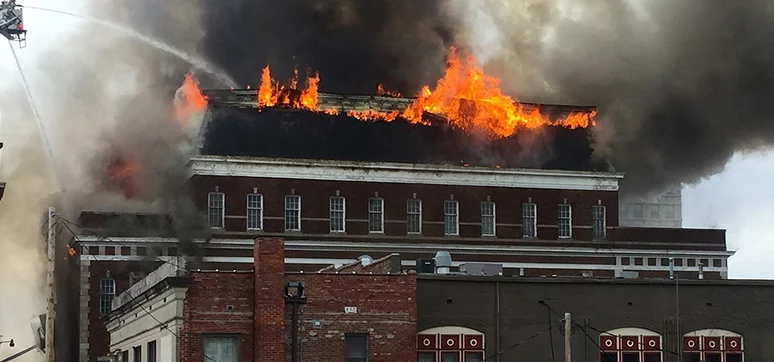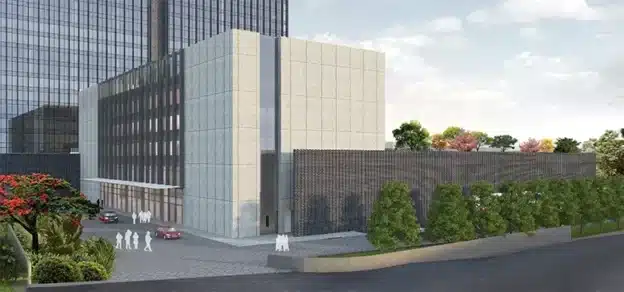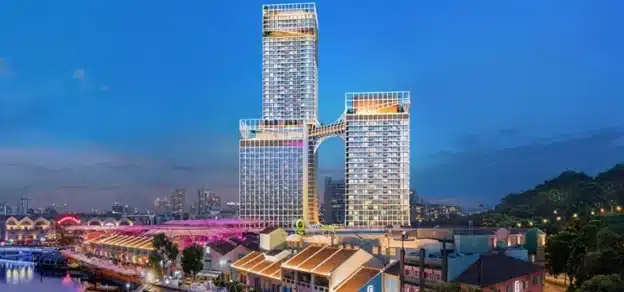In the last decade or so, rapid urbanisation has been witnessed throughout the world, thereby pushing developers to utilise space efficiently by building increasingly taller towers. 2014 was a landmark year, which saw the completion of 97 skyscrapers (height more than 200 meters) across the world. Buildings are getting taller and being completed at a faster rate than ever before. With buildings going higher, the issue of life safety becomes even more pertinent. Forms of egress and fire compartmentation are crucial to surviving high-rise fires. The complete section pertaining to façade and external wall covering system design has been refreshed in the UAE Fire and Life Safety Code of Practice – 2018 with an aim to raise the standard for supplemental materials and reduce the cladding’s combustibility and flame spread.
It is the desire of every architect and engineer to design and build a tower which is distinct among others in terms of design and appearance. New façade and external wall covering system design comes with new fire safety challenges in terms of flame propagation and spread from one storey to another storey of the building. There have been many recent fires witnessed around the world. External wall cladding and façade system arguably played a supporting role to the flame propagation in all the recent tower fires.

These incidents lead us as fire engineers, fire prevention authorities, building designers and product manufacturers to look deeper into the façade and external cladding system design to improve the system design, local legislation, code requirements, materials used, installation methodologies, inspections of an installed system, and maintenance in order to altogether have a better and fire-safe system.
Towards this purpose, the complete section pertaining to façade and external wall covering system design has been refreshed in the UAE Fire and Life Safety Code of Practice – 2018 with an aim to raise the standard for supplemental materials and reduce the cladding’s combustibility and flame spread. This also requires a combination of small-scale and full-scale fire testing to ensure the safest cladding in the world to be used in UAE.
Codes and Standards

In the Middle East, building codes are largely influenced by American code and standards such as the International Building Code (IBC) and the National Fire Protection Association (NFPA). Put simply, a “Code” specifies where a type system is required, where a “Standard” sets out how to design that system. For example, NFPA 5000 building code Specifies Sprinklers in a high-rise building. The sprinkler system must be designed to NFPA 13 standard for sprinkler design.
In Dubai, the primary building “code” is the UAE Fire Code. This building code is the primary basis for the design of all buildings. This code provides designers detailed design guidelines for where a given system is required and what standard it needs to be designed for. For smoke control systems, the UAE Fire Code requires systems to be designed with standards such as NFPA 92.
Fire Safety for Different Building Heights Firefighting strategies vary for different building heights. Typically for low- and mid-rise buildings, external building fire-fighting can be accomplished. However, when the building heights increase, so do the challenges. It is generally considered, and widely understood that typically internal fire-fighting takes place in or around 23m due to ladder restrictions of high-reach fire trucks. This is further emphasised in the UAE Fire Code in regard to emergency fire vehicle access.
Fire Safety Principles for Typical Modern Building Building codes typically cover a vast array of different requirements related to buildings. However, fire safety principles largely remain the same internationally given the nature of fire dynamics, these can be distilled into the following key points:

• A single fire incident is considered at any one time (design assumption)
• Acts of arson not considered i.e. multiple ignition sources (design assumption)
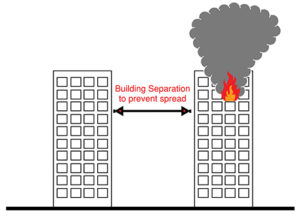
• Design should contain the fire within the room of origin (design criteria)
• Design should typically provide two routes to escape in most circumstances (design criteria)
• The distance should be limited to travel distance to a safe area (design criteria)
• A single fire scenario should not block multiple escape routes (guiding principle)
Typically, a building fire strategy will include a wide number of fire protection measures as part of the standard building measures. These are illustrated as follows:
Façade Fire Safety Objectives
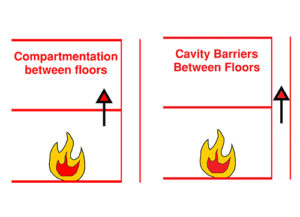
Of the key fire safety principle mentioned above, similar principles of fire safety can be considered for the external building envelope as follows:
• Objective 1 – The design should prevent external fire from spreading to other buildings
• Objective 2 – The design should prevent internal fire spread within the building
• Objective 3 – The design should prevent external fire spread from outside the building
• Objective 4 – The design should protect escape routes
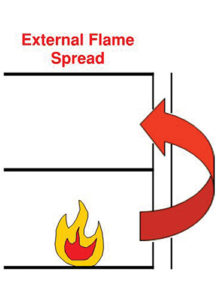
The façade fire safety objectives mentioned above are part of the overall fire safety objective of the building. While the building fire safety objective focuses on both fire suppression and compartmentation, the façade fire objective focuses on limiting the spread of fire from one building to another, one floor to another, etc. For effective building fire safety, all the packages of protection shall go hand in hand. If not contained in the compartment, fire escalates horizontally on the floors and, vertically via the vertical openings, communicating spaces, façades, and external wall coverings.
In the case of a curtain wall system, the floor-to-floor fire spread has been worked by many fire engineers and researchers in the past. From a fire dynamics perspective, we know that flames emitting from an external window can extend higher than 5 meters above the top of windows. Analysis of fire compartment experiments (Thomas and Heselden, 1972) helped to more fully understand the physical phenomenon of ventilation-controlled fire.
Ventilation-controlled fire represents the scenario where a fire burning in a building breaks the window glazing, permitting hot gases to flow out the top portion of the opening. A portion of the hot gases is unable to burn inside the room due to limited air (ventilation-controlled) but, upon movement to the exterior, encounter sufficient air entrainment, allowing the hot fuel gases to burn outside the building. The result is a flame projecting out and upward from the window. The exterior building detailing, articulations incorporated as elements of the façade and structural floor plate changes can all impact the flame propagation and associated corrective and radiant heat exposure to the façade.
Apart from the floor-to-floor flame spread, there is fire spread within the façade system as well. combustible components (e.g. insulation), the ventilated air cavity located behind the cladding, the risk can be reduced by using, non-combustible or low-combustible elements.

The latest edition of UAE Fire and Life Safety Code of Practice has made required and effective revisions pertaining to the façade and external wall covering systems such as Bituminous material not permitted on primary substrate, improved clarity in the façade related sections, detailed roles and responsibilities and stringent testing and certification requirements have been introduced.
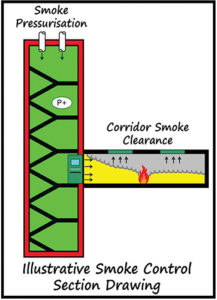
Requirements having to do with a cavity fire barrier, thermal barrier, openings (windows, doors, ventilation) flashing, openings on exterior walls, and perimeter fire barrier have been detailed and improved. Core tests, the panel as product tests, and wall assembly tests have also been introduced. Core and panel to be tested against EN 13501-1 and ASTM D1929, and full-scale wall assembly to be tested against BS 8414-1 or 2 or NFPA 285 or FM 4881 or ISO 13785-2.
Floor-to-floor flame propagation through façades and external wall coverings has led to some devastating results in the past in the UAE and around the world. The risk of super high-rise buildings required consideration of several factors including engineering design of the sprinkler system, fire department response capabilities, occupancies, associated fire loads, building evacuation approach, and compartmentation features.
With the appropriate evaluation of risk and associated factors, a correct façade and external wall coverings can be chosen. Being at the forefront of super high-rise building design and development, UAE has revised its codes, standards, testing requirements, inspections and certifications to reduce such incidents in the future and hence, making our future safe here in the United Arab Emirates.
In order to define a successful faced fire strategy, we must first define an unsuccessful strategy or an unfavourable outcome. From the unfavourable condition, it is possible to work back and design the façade to mitigate any potential fire spread path.
Façade Fire Safety Objective 1
The designer can address the potential external fire spread challenges to other buildings by either creating remoteness between buildings to avoid radiation or products of combustion and burning debris impacting adjacent buildings or by fire rating external walls near to adjacent buildings. The latter typically becoming cost-prohibitive.
Façade Fire Safety Objective 2
The designer can address the potential internal fire spread challenges by establishing appropriate internal fire-stopping protection to prevent fire and smoke spread from the room of fire origin to other parts of the building. The designer must also establish appropriate cavity barrier protection.
Façade Fire Safety Objective 3
The designer can address the potential external fire spread challenges by establishing safeguards such as sprinkler protection, spandrels and appropriate façade specification.
Façade Fire Safety Objective 4
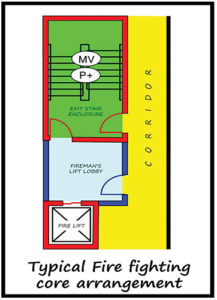
The designer can address the potential risk to escape routes by ensuring the building architecture is in compliance with the fire code in regard to escape distances, number of routes and discharge. In particular, reference can be made to a simple exit discharge arrangement for a high-rise tower to illustrate appropriate discharge.
A further example of protecting escape routes includes the firefighter lift lobby arrangement which allows firefighters the ability to set up a staging point within the firefighting lobby while the building occupant evacuates through the stairs. The additional provision of smoke clearance within the corridors provides additional protection to the occupants within the early stages of fire development.
Conclusion
In conclusion, façade fire strategy can be defined by four key objectives. Where these objectives are achieved the strategy can be considered successful. Failure to consider the façade fire safety objectives can result in an unsuccessful façade fire strategy. It is the responsibility of all stakeholders from the design to the operation, over the life cycle of the building to ensure the strategy is successful.
